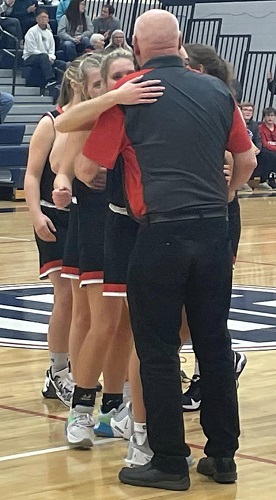
Using Heads in the Heat of Competition
December 20, 2013
By Rob Kaminski
MHSAA benchmarks editor
With so much recent attention to the risks and recognition of concussions in collision sports, athletic leaders have put their heads together to address far more common – but often overlooked – threats to the health of our student-athletes: heat and sudden cardiac arrest.
The No. 1 killer of young athletes is sudden cardiac arrest, while heat stroke victims can surpass that during the year’s hottest months. While the moment of impact leading to a concussion is totally unpredictable, athletic trainers, coaches and administrators have the ability to diminish the occurrences of cardiac arrest and heatstroke. Typically, there is a pre-existing condition, or family history suggesting probabilities for sudden cardiac arrest, which can be treated when detected. And, the perils associated with hot weather – heat stroke, prostration – are almost always completely preventable.
The MHSAA has addressed both issues recently. With assistance from numerous medical governing bodies, the annual pre-participation physical form was revamped and expanded prior to the 2011-12 school year to include comprehensive information regarding participants’ medical history.
In May, the Representative Council adopted a Model Policy for Managing Heat & Humidity (see below), a plan many schools have since adopted at the local level. The plan directs schools to monitor the heat index at an activity site once the air temperature reaches 80 degrees and provides recommendations when the heat index reaches certain levels, including ceasing activities when it rises above 104 degrees.
The topic of heat-related illnesses receives a lot of attention at the start of fall when deaths at the professional, collegiate and interscholastic levels of sport occur, especially since they are preventable in most cases with the proper precautions. In football, data from the National Federation of State High School Associations shows 41 high school players died from heat stroke between 1995 and 2012.
“We know now more than we ever have about when the risk is high and who is most at risk, and we’re now able to communicate that information better than ever before to administrators, coaches, athletes and parents," said Jack Roberts, executive director of the MHSAA. “Heat stroke is almost always preventable, and we encourage everyone to avail themselves of the information on our website.
“Schools need to be vigilant about providing water during practices, making sure that students are partaking of water and educating their teams about the need for good hydration practices.”
All of which is not to say concussions aren’t a serious matter; they are. In fact, leaders in sport safety can take advantage of the concussion spotlight to illuminate these additional health threats.
A recent New York Times story (May 2013) by Bill Pennington featured a February 2013 gathering in Washington organized by the National Athletic Trainers Association. In the article, Dr. Douglas J. Casa, professor of kinesiology at the University of Connecticut and Chief Operating Officer of the Korey Stringer Institute (founded in the late NFL offensive lineman’s name to promote prevention of sudden death in sport), suggests just that.
“All the talk about head injuries can be a gateway for telling people about the other things they need to know about, like cardiac events and heat illness,” said Casa in the article. “It doesn’t really matter how we get through to people as long as we continue to make sports safer.”
Education and prevention methods need to find a permanent place in school programs if those programs are to thrive and avoid becoming targets at which special interest groups can aim budgetary arrows.
Dr. Jonathan Drezner, the president of the American Medical Society for Sports Medicine, said in the New York Times piece that sudden cardiac arrest is “so incredibly tragic and stunning that people aren’t comfortable putting it into the everyday conversation. I do wish, to some extent, it was something people talked more about because we are getting to a place where we could prevent many of these deaths.”
When it comes to heat-related deaths or illnesses, the prevention efforts can be even more successful by educating the masses. And, these efforts can be done at minimal cost to schools.
“That’s the thing about curtailing exertional heat illness: it’s 100 percent preventable, and unlike other health threats to athletes, the solutions can be very low-tech and inexpensive,” said Dr. Michael F. Bergeron, the director of the National Institute for Athletic Health & Performance at the University of South Dakota’s Sanford Medical Center, in the New York Times story.
To assist with cost and data maintenance, the MHSAA has teamed with Sports Health to provide schools with psychrometers (heat measurement instruments) at a discounted rate, and has built online tools to track heat and humidity conditions.
Managing heat and humidity policy
- Thirty minutes prior to the start of an activity, and again 60 minutes after the start of that activity, take temperature and humidity readings at the site of the activity. Using a digital sling psychrometer is recommended. Record the readings in writing and maintain the information in files of school administration. Each school is to designate whose duties these are: generally the athletic director, head coach or certified athletic trainer.
- Factor the temperature and humidity into a Heat Index Calculator and Chart to determine the Heat Index. If a digital sling psychrometer is being used, the calculation is automatic.
If the Heat Index is below 95 degrees:
All Sports
- Provide ample amounts of water. This means that water should always be available and athletes should be able to take in as much water as they desire.
- Optional water breaks every 30 minutes for 10 minutes in duration.
- Ice-down towels for cooling.
- Watch/monitor athletes carefully for necessary action.
If the Heat Index is 95 degrees to 99 degrees:
All Sports
- Provide ample amounts of water. This means that water should always be available and athletes should be able to take in as much water as they desire.
- Optional water breaks every 30 minutes for 10 minutes in duration.
- Ice-down towels for cooling.
- Watch/monitor athletes carefully for necessary action.
Contact sports and activities with additional equipment:
- Helmets and other possible equipment removed while not involved in contact.
- Reduce time of outside activity. Consider postponing practice to later in the day.
- Recheck temperature and humidity every 30 minutes to monitor for increased Heat Index.
If the Heat Index is above 99 degrees to 104 degrees:
All Sports
- Provide ample amounts of water. This means that water should always be available and athletes should be able to take in as much water as they desire.
- Mandatory water breaks every 30 minutes for 10 minutes in duration.
- Ice-down towels for cooling.
- Watch/monitor athletes carefully for necessary action.
- Alter uniform by removing items if possible.
- Allow for changes to dry T-shirts and shorts.
- Reduce time of outside activity as well as indoor activity if air conditioning is unavailable.
- Postpone practice to later in the day.
Contact sports and activities with additional equipment
- Helmets and other possible equipment removed if not involved in contact or necessary for safety.
- If necessary for safety, suspend activity.
Recheck temperature and humidity every 30 minutes to monitor for increased Heat Index.
If the Heat Index is above 104 degrees:
All sports
- Stop all outside activity in practice and/or play, and stop all inside activity if air conditioning is unavailable.
Note: When the temperature is below 80 degrees there is no combination of heat and humidity that will result in need to curtail activity.
PHOTO: The Shepherd volleyball team includes hydration during a timeout in a match this fall.

DeMott's Long-Revered Legacy Grows to Include All-Time Wins Record
By
Paul Costanzo
Special for MHSAA.com
January 11, 2023
This past Friday night felt like a home game for Al DeMott.
 Family, friends and former players were packed into the stands to watch him set the MHSAA record for career wins by a girls basketball coach.
Family, friends and former players were packed into the stands to watch him set the MHSAA record for career wins by a girls basketball coach.
There was a postgame celebration on the court, and a congratulatory message displayed on the video board.
Of course, DeMott and the Wolves hadn’t just won a game in their home gym – they had done it at Unionville-Sebewaing.
But anywhere in the Thumb can feel like home.
“USA, they really did a lot,” DeMott said. “They put a thing up on the board, their coach came out after the game and said all kinds of nice things. USA was a very generous host. They went above and beyond.
“That’s the way it is in Thumb basketball; we all look after each other and support each other. In all sports, really. When one team goes on a run, the whole Thumb gets on the bandwagon.”
Sandusky’s win was the 798th of DeMott’s career, putting him ahead of retired Detroit Country Day coach Frank Orlando on the all-time list.
It’s a record more than 40 years in the making, as DeMott took over the program in 1979. In that time, Sandusky has won 23 league titles, 27 District titles, seven Regional titles and earned an MHSAA Finals runner-up finish (1999). The program hasn’t had a losing season since 1982.
“I’ve been doing it a long time,” DeMott said. “Our program has had a lot of success. We’ve had a pretty good run going for a lot of years. The numbers don’t really mean that much to me. It’s nice for our program that it’s been successful as it has. That it’s been steady for a long time. There are a lot of good people that have done a good job.”
DeMott’s career record stands at 799-206, as the Wolves won another game Tuesday night to push their season record to 9-2.
Before he’s done, the record will no doubt be well above 800. How far above depends on how long DeMott sticks around. Right now, there’s no immediate plan to stop.
 “Every year, when you get done with the year and your season ends, you’re tired,” DeMott said. “But I’m still having a lot of fun doing it. Another thing, God’s blessed me with good health. I’ve been fortunate to keep going strong with this. I’ve been working on trying to get someone to take it over – I’ve got a granddaughter in eighth grade, and I would like to sit and watch her.”
“Every year, when you get done with the year and your season ends, you’re tired,” DeMott said. “But I’m still having a lot of fun doing it. Another thing, God’s blessed me with good health. I’ve been fortunate to keep going strong with this. I’ve been working on trying to get someone to take it over – I’ve got a granddaughter in eighth grade, and I would like to sit and watch her.”
One thing that keeps DeMott going is the support he gets from those around him in the program.
He’s had the opportunity to coach with his three daughters, Desiree, Allison and Marissa, who also played for him. His longtime assistant coach and childhood friend, Ray Lee, has been on the staff since 1982. DeMott said that during his time at Sandusky, he’s had only six or seven JV coaches.
“I have such a good support system,” DeMott said. “I have loyal assistant coaches.”
The community, both in Sandusky and throughout the Thumb, also has shown DeMott tremendous support, even as he was struggling to get the program off the ground in the early years.
“With the start I had here, if somebody got off to the start I did, they’d be gone, probably,” DeMott said. “It’s been phenomenal. I can’t believe all the texts and emails and calls I’ve got. People have gone above and beyond. There’s been a lot of support. We’ve always got really good support.”
And, of course, nothing can beat the support that DeMott gets at home, as his wife Tammy has been there since the beginning.
“My wife has been a saint,” DeMott said. “When I first started doing this coaching, she was a little iffy about it. When I first started, I was working at the bank and I only had two weeks vacation. We used to use one of the weeks of vacation to go to team camp. She stays up and does stats with me. She’s my biggest supporter I’ve ever had.”
All that support has allowed DeMott to build a consistent winner at a public school with an enrollment just over 300 students.
He started a youth program fairly early in his time at Sandusky, and it’s still going strong. He said there were 40 third and fourth graders in the gym this past Saturday starting their latest season.
As kids grow up in the program, they dream of one day playing for the varsity team and DeMott.
 “This achievement couldn’t have been accomplished by a more humble and deserving person,” said Haley Nelson, a 2018 Sandusky grad who played for DeMott before playing at Saginaw Valley State. “In Sandusky, playing under Coach DeMott is something you look forward to as soon as you start playing basketball in elementary school. He’s built a standard as to what Sandusky girls basketball is, and it made you want to work hard to live up to it. The program he’s built is a testament to his hard work and dedication year-round. I think it would be tough to find another high school coach as committed to their program as Al is. He sees each of his players as people far beyond what they can contribute on the court, and for that reason, the impact he has on his players extends far beyond basketball.”
“This achievement couldn’t have been accomplished by a more humble and deserving person,” said Haley Nelson, a 2018 Sandusky grad who played for DeMott before playing at Saginaw Valley State. “In Sandusky, playing under Coach DeMott is something you look forward to as soon as you start playing basketball in elementary school. He’s built a standard as to what Sandusky girls basketball is, and it made you want to work hard to live up to it. The program he’s built is a testament to his hard work and dedication year-round. I think it would be tough to find another high school coach as committed to their program as Al is. He sees each of his players as people far beyond what they can contribute on the court, and for that reason, the impact he has on his players extends far beyond basketball.”
Nelson is one of many Sandusky players who have gone onto play at the next level. Many have stayed connected to the sport through coaching, as well. But in general, DeMott touts the academic success of his program, and the pride he has in the citizens his former players have grown to be.
“A lot of our former players, they’ve all done a lot of really good things,” DeMott said. “I couldn’t be prouder. There were quite a few there (at USA). It meant a lot to see them.”
One former player-turned-coach is Wayne State women’s basketball coach Carrie Lohr, who has set records of her own. She’s in her 12th season at Wayne State, and has won nearly 200 games. She became the program’s all-time winningest coach in 2019.
She counts DeMott as one of her biggest influences.
"Al is truly one of the best coaches in the state of Michigan," Lohr said. "I believe he could coach any team or sport to its highest potential. Al has an unwavering dedication and passion for the game of basketball and teaching young people. He is selfless, positive, consistent, knowledgeable and truly cares about the players he leads.
“Playing for Coach Al DeMott is still some of my best basketball memories ever. He has truly made a positive impact on my life as he has done for so many who have worn the Sandusky jersey. I wouldn't be where I am today without his mentorship. I am forever grateful to him and his support of me long after I left the court."
With the record behind him, DeMott now hopes the focus can return to this year’s team, which is 9-2 with its losses coming by a combined five points.
It’s clear he’s excited about this group, as the energy in his voice ratcheted up when asked about his players.
“I’ve got an awesome group to coach,” DeMott said. “They’re really good, smart, hard workers. They want to be successful, and they really like to play together. They love playing together. They’re a special group.”
 Paul Costanzo served as a sportswriter at The Port Huron Times Herald from 2006-15, including three years as lead sportswriter, and prior to that as sports editor at the Hillsdale Daily News from 2005-06. He can be reached at [email protected] with story ideas for Genesee, Lapeer, St. Clair, Sanilac, Huron, Tuscola, Saginaw, Bay, Arenac, Midland and Gladwin counties.
Paul Costanzo served as a sportswriter at The Port Huron Times Herald from 2006-15, including three years as lead sportswriter, and prior to that as sports editor at the Hillsdale Daily News from 2005-06. He can be reached at [email protected] with story ideas for Genesee, Lapeer, St. Clair, Sanilac, Huron, Tuscola, Saginaw, Bay, Arenac, Midland and Gladwin counties.
PHOTOS (Top) Sandusky girls basketball coach Al DeMott stands alongside his current team after they helped him break the MHSAA record for girls basketball victories Friday at Unionville-Sebewaing. (Middle) The USA scoreboard celebrated DeMott’s accomplishment. (Below) Players line up to congratulate DeMott on his milestone win. (Photos courtesy of Sandusky High School.)

